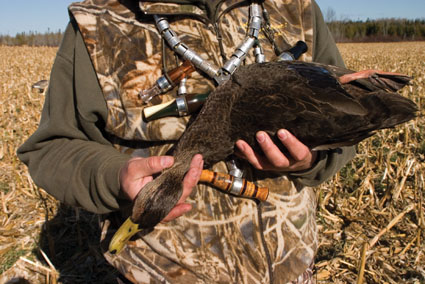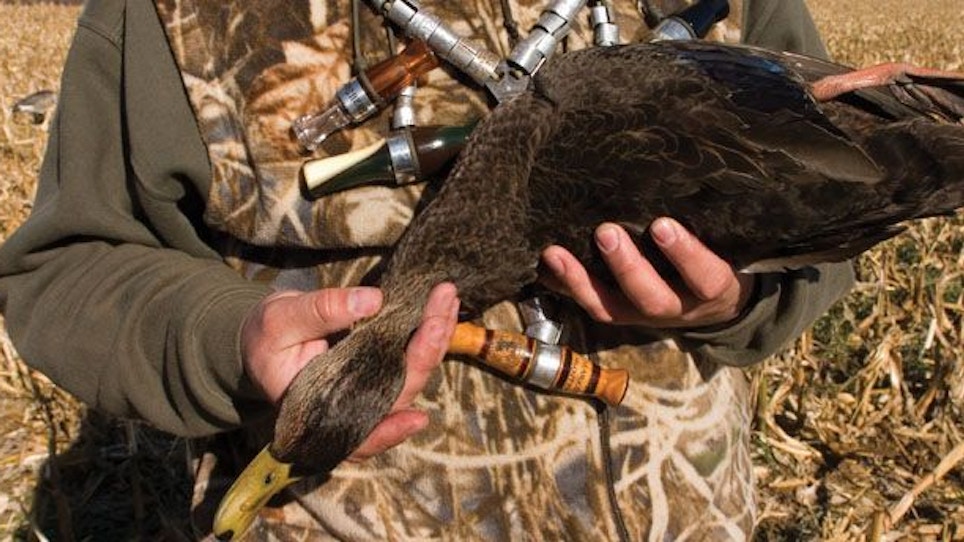 Overcalling is probably the biggest mistake callers make. “Don’t over-call,” Hasson states. “Black ducks can be extremely call-shy. If you try to blow them out of the sky with calling, they’ll keep on hauling.”
Overcalling is probably the biggest mistake callers make. “Don’t over-call,” Hasson states. “Black ducks can be extremely call-shy. If you try to blow them out of the sky with calling, they’ll keep on hauling.”
Hasson says the raspier the call, the better. Black ducks make the same call as a mallard, and a raspy mallard call is perfect.
“If the blacks are really call-shy on the first pass or they won’t slow down, I’ll get on the goose call,” explains Hasson. “It’s incredible how they will sometimes double-back to the soft clucks and moans of a goose. But you’ve got to be careful if you only have a pair of goose decoys, because you can blow the blacks away with heavy calling.”
Full camouflage is essential when hunting black ducks, probably more so than when hunting greenheads. I learned this the first morning as we were setting up in a freshly harvested cornfield prior to daylight. Hasson made us spend as much time camouflaging our layout blinds as we did setting up the decoy spread. Even during the hunt, he stopped a few times during a lull in the action to stand out in front of the spread and motion to us where we needed to stuff a corn stalk or two in the blind.
“Camouflage has got to be top-end,” Hasson says. “You can’t be in something that looks like a blind out there; you must blend in. This is why I take so much time to make sure setups are concealed.”
A Successful Hunt, But Very Wet
Finished with his cigarette, he disappears over the dyke and into the storm with Cassey, the female yellow Lab that wasn’t at all taken with hunting in a hurricane. When they return, Curtis has my two black ducks in hand, and he announces that since the darkness is nearly cloaking the marsh, it’s time to call it quits for the evening.
We slosh back through the marsh and up the hill, leaning into the wind with our heads down and our guns shouldered. An inviting ranch-style home waits on top. The three of us file into the barn and shuck our drenched gear as the tin roof tattoos an irregular drum beat in the gale. Weary, but hurried along by the downpour, we then run 50 yards to the house and pile up one-by-one in the doorway, like rush-hour traffic. As I close the door behind us, I smell the aroma of moose tourtière (a French-Canadian dish consisting of meat, potatoes and spices topped with a pie crust) and immediately I forget all the discomforts of the storm we left behind.
After drying off in the foyer, I walk into the den, the most noticeable feature of which is the large window overlooking the bay. The A-frame ceiling is lined with stuffed black ducks, eiders, long-tailed ducks and ruffed grouse, and snow and Canada geese. As I walk through the dimly lit living room, I gaze at some of the finest waterfowl art I’ve ever seen — all originals. The smell of cooking is potent as I enter a chatter-filled dining room; here Michelle Larson, the wife of the late Lars Larson, famous wildlife and waterfowl artist, welcomes a far-from-home Alabama boy. The rest of the evening is spent eating and listening to the stories behind the paintings.
New Brunswick Black Ducks
Black ducks are predominately found along the coast in the Northeast from Newfoundland southward to eastern Virginia, but can be found as far west as Minnesota. They will winter as far south as northern Florida and as far west as Iowa. However, they are abundant along the Canadian Maritimes.
The black duck is slightly larger than a mallard and resembles a mallard hen. From a distance the birds do in fact look black, but on closer inspection, the feathers are actually brown.
Blacks can be found in coastal marshes, harvested grain fields and small beaver ponds. They’re a large dabbling duck that feeds on seeds, roots, stems, grain, aquatic plants and insects, crustaceans, mollusks and fish. While they breed in a variety of wetland habitats such as salt marshes, beaver ponds and boreal bogs, they do winter primarily in saltwater along the coast, but can still be found inland in freshwater. New Brunswick is a honeyhole for the waterfowler seeking the elusive black duck. Large populations of black ducks breed farther north in Labrador and Newfoundland and in the fall migrate down the coast into New Brunswick and Nova Scotia.






